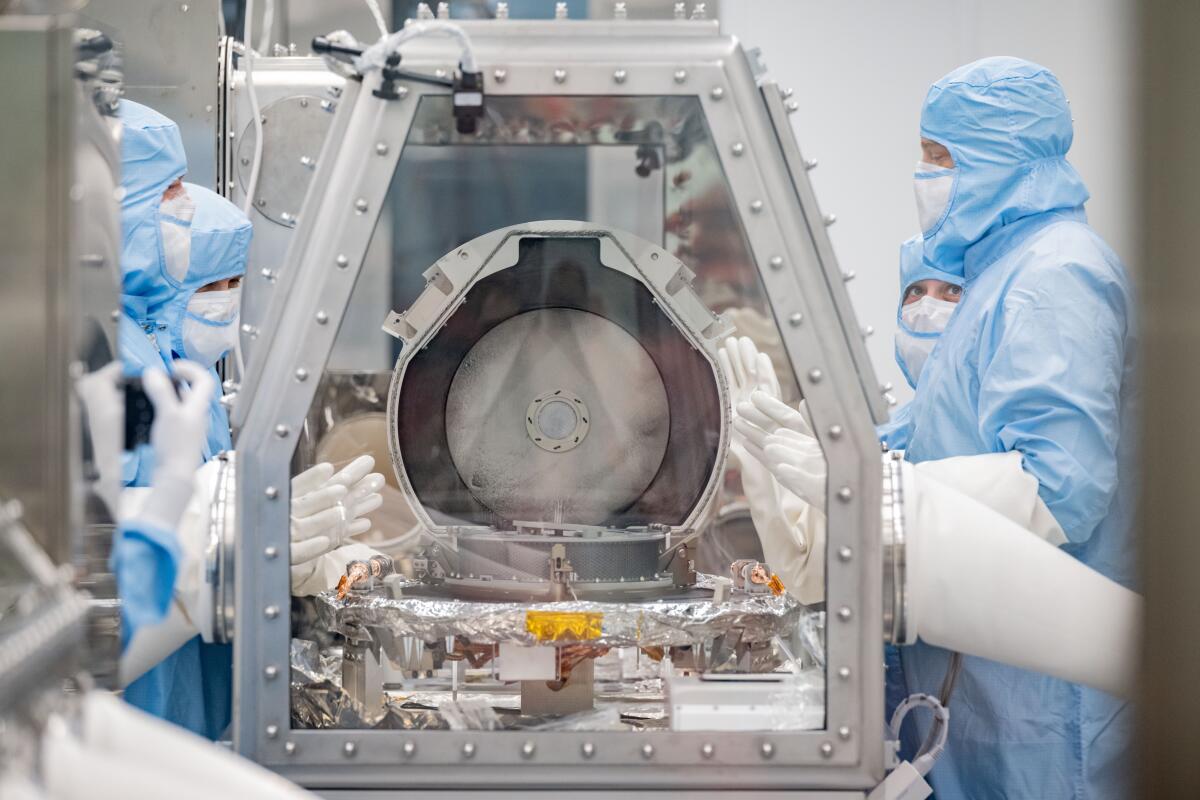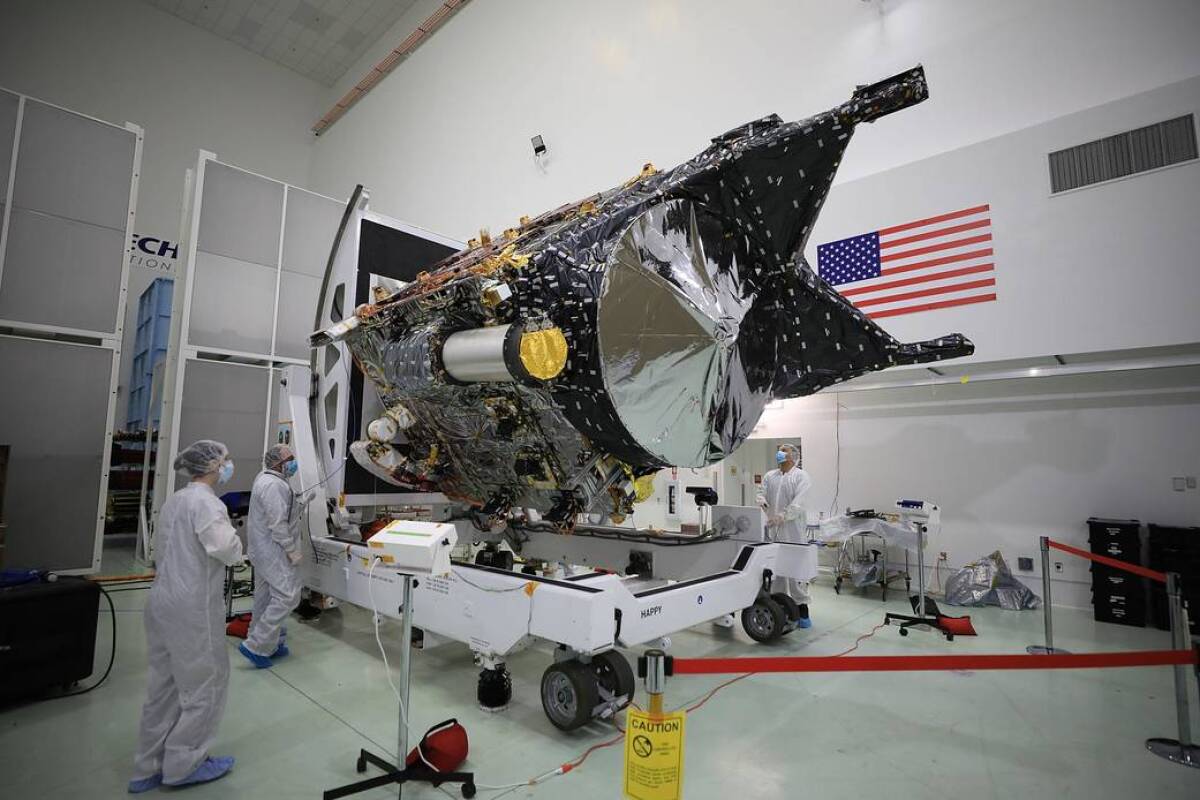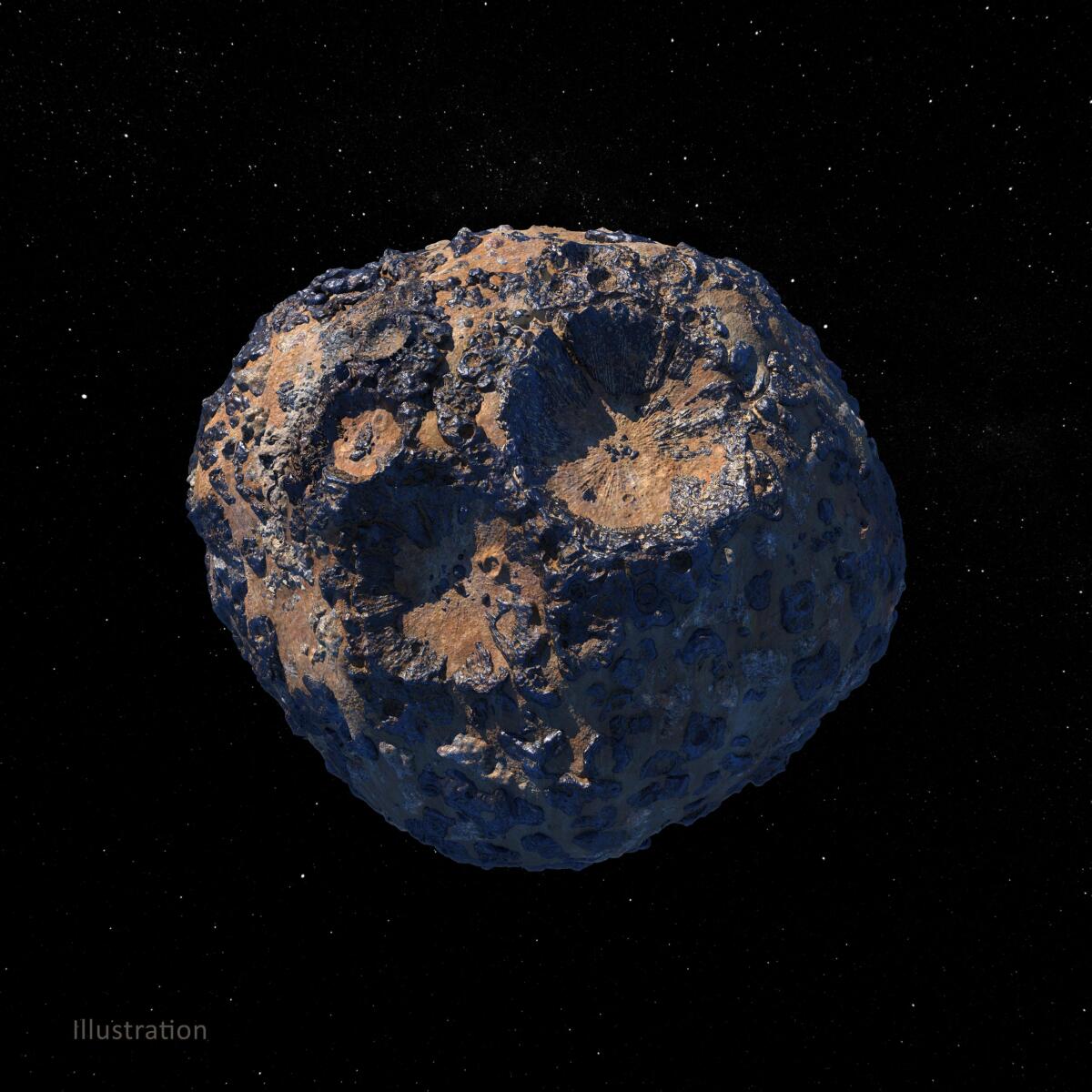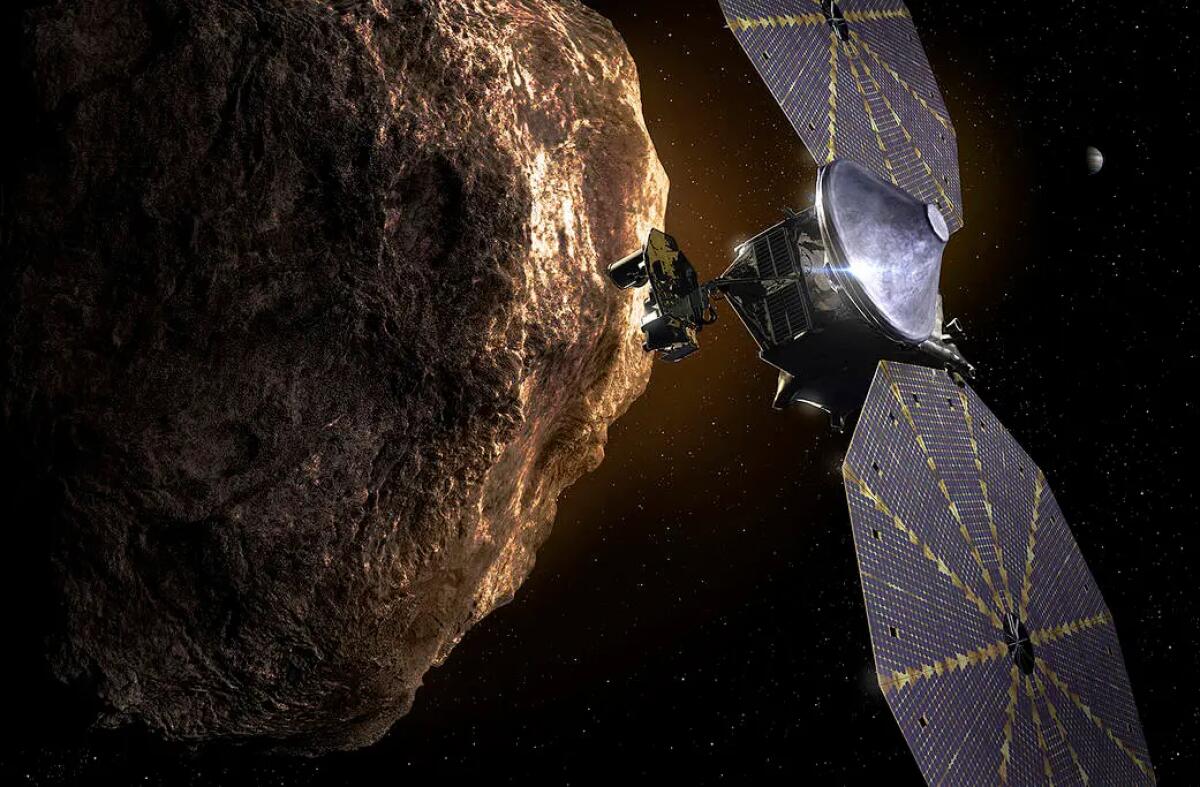An uncommon disc-shaped object from house landed final month on the barren sands of a U.S. army testing floor.
Scorched from its fiery journey by the ambiance, the capsule was lifted by helicopter and brought to a custom-built clear room on the Utah Check and Coaching Vary, the place it sat unopened below a steady circulate of nitrogen to keep away from contamination by the germs of its new house planet.
It was flown the subsequent day to NASA’s Johnson Area Heart in Houston. There, a hazmat-suited group rigorously pried open the capsule to disclose the extraterrestrial treasure inside.

Staff at NASA’s Johnson Area Heart in Houston take away the lid of the OSIRIS-REx pattern return canister inside a glovebox to stop contamination.
(Robert Markowitz / NASA-JSC)
NASA will announce its preliminary findings on Wednesday. What we already know is that the capsule incorporates a pattern from the asteroid Bennu, a roughly 4.6 billion-year-old relic of the earliest days of our planetary neighborhood.
The completion of the pattern’s 1.2-billion-mile journey to Earth is a part of a trio of missions in a season that Lori Glaze, NASA’s chief of planetary science, has known as “asteroid autumn.”
Lengthy well-known for killing the dinosaurs and starring in apocalypse films, asteroids are primarily building particles from the constructing of the photo voltaic system. The identical collapsed cloud of fuel and mud that condensed in locations to create the planets additionally produced smaller rocks that by no means achieved planet measurement or standing.
This fall, NASA marks milestones in three completely different missions that discover unanswered questions concerning the course of that made Earth, the stuff that makes the photo voltaic system and the way we’d save ourselves ought to a a lot bigger house rock come hurtling our method.
Mission 1: OSIRIS-REx/OSIRIS-APEX
The Origins, Spectral Interpretation, Useful resource Identification, and Safety-Regolith Explorer spacecraft (helpfully nicknamed OSIRIS-REx) launched in 2016 and headed to Bennu with the aim of amassing NASA’s first asteroid pattern and delivering it again to Earth.
The very best proxies for asteroids now we have on Earth are meteorites, small rocks from house that survived the fiery journey by Earth’s ambiance. (Those who dissipate upon entry, as an estimated 95% of such objects do, are known as meteors.)
Some meteorites begin out as asteroid fragments, although there’s no solution to know what bigger physique they was a part of. Regardless, lots of key details about them will get misplaced in the course of the lengthy journey to Earth.
By the point one lands on the floor, friction from barreling by the ambiance has seared its outer floor. All meteorites are coated in what’s generally known as “fusion crust,” a tough rind of glassy materials left behind when the outside melted upon entry. They’re additionally contaminated with germs from Earth’s air and soil and will have spent years uncovered to the weather earlier than being discovered.
With OSIRIS-REx, “the target is to deliver again an historical piece of the early photo voltaic system that’s pristine,” mentioned astrobiologist Jason Dworkin, the mission’s undertaking scientist at NASA’s Goddard Area Flight Heart in Maryland. “You need to use these leftovers of the formation of the photo voltaic system to assemble what occurred in that formation.”

The OSIRIS-REx spacecraft takes a pattern of the floor of the asteroid Bennu in 2020, dispersing rock and particles within the course of.
(NASA by way of Related Press)
The spacecraft collected practically 9 ounces (250g) of rocks, mud and different particles throughout its touch-and-go go to to Bennu’s Hokioi crater in October 2020. The dear cargo was stowed within the capsule that landed within the Utah desert.
NASA scientists will analyze the pattern’s chemistry to assist them work out how the compounds crucial for all times advanced from these early supplies. However many of the payload shall be frozen and archived in order that future scientists — a few of whom could not but have been born — will have the ability to examine it utilizing applied sciences extra superior than what’s accessible as we speak.
“That’s what excites me essentially the most,” Dworkin mentioned. “I’ve my very own science, however the future is what’s thrilling.”
The craft that traveled to Bennu has already moved on to its subsequent task. Now named OSIRIS-APophis EXplorer, or OSIRIS-APEX, the craft is headed to Apophis, a peanut-shaped asteroid that, for a short time, appeared extra more likely to smash disastrously into Earth than any recognized object within the photo voltaic system.
Although that chance has been decisively dominated out, Apophis continues to be on observe to come back nearer to Earth than has any object of its measurement in recorded historical past. Scientists are making the most of the April 2029 flyby to seize a pattern of that rock as properly. Apophis is a stony asteroid, the most typical sort of probably hazardous asteroid. Finding out its composition may show very useful in understanding the way to defend the planet from extraterrestrial threats.
Mission 2: Psyche
On Thursday, a SpaceX rocket will carry off from Kennedy Area Heart to start a 2.2-billion-mile journey to 16 Psyche, a metallic asteroid that orbits between Mars and Jupiter. It’s definitely worth the lengthy voyage: Psyche, the most important recognized metallic object within the photo voltaic system, might be product of the identical metals that type the cores of the rocky planets.
Although Earth’s core is actually nearer — rather less than 4,000 miles beneath the floor — it’s truly tougher to entry. Warmth and strain would obliterate any probe properly earlier than it reached the molten rock, which is hotter than the floor of the solar.
“We will study extra about Earth’s core and the core of the opposite rocky planets by going to house, which is weirdly simpler than going to go to them in individual,” mentioned Lindy Elkins-Tanton, the mission’s principal investigator.
The spacecraft — additionally known as Psyche — was initially scheduled to launch Thursday, however its departure was delayed after engineers noticed a problem with its thrusters. The craft is predicted to succeed in the asteroid’s orbit in August 2029 and can then spend greater than two years circling the thing. Engineers from NASA’s Jet Propulsion Laboratory in La Cañada Flintridge will handle the mission, which is led by Arizona State College.

NASA’s Psyche spacecraft in a clear room final yr at Astrotech Area Operations Facility close to the Kennedy Area Heart in Florida.
(NASA)
There’s no touchdown or sampling deliberate. That’s partially as a result of exorbitant expense of hauling a pattern throughout a lot house. Nevertheless it’s additionally as a result of nobody is kind of certain what Psyche’s floor appears like.

An illustration of what scientists suppose the asteroid Psyche appears like.
(Peter Rubin)
Our solely glimpses of the asteroid up to now are just a few blurry telescope pictures. Primarily based on its actions, scientists suppose that it’s large (173 miles throughout at its broadest level, concerning the width of Massachusetts) and potato-shaped. Evaluation of the sunshine reflecting off the asteroid and density estimates primarily based on its form and presumed mass recommend it’s extremely metallic. Past that, it’s a thriller.
“It’s a main exploration of a brand new form of world, one thing that we actually are going to be shocked by,” mentioned Elkins-Tanton, a planetary scientist at Arizona State.
The craft is provided with a pair of cameras that may {photograph} gentle in each the seen spectrum and in near-infrared wavelengths the human eye can’t see by itself. These high-resolution footage will reveal the asteroid’s topography and mineral make-up. Probes on the craft will gather information on its magnetic discipline, chemistry and gravity, all of which give clues to its origins, inside construction and exterior composition.
Scientists imagine Psyche may very well be the metallic core of a planetesimal, an early model of a rocky planet that got here collectively within the chaos of the photo voltaic system’s formation solely to have its outer crust battered away in collisions with different objects. Or it may very well be one thing completely completely different.
Psyche “is a really uncommon object. It should come from an uncommon course of,” Elkins-Tanton mentioned. “And my favourite factor can be if it turned out to not be a part of a core, and as an alternative taught us one thing utterly stunning about photo voltaic system formation.”
Mission 3: Lucy
Why go to a single asteroid when you may go to a bunch? That’s the aim of Lucy, a spacecraft that makes the primary of 10 deliberate stops on its house rock tour subsequent month.
Named for the fossilized stays of an early human ancestor found in Ethiopia in 1974, the mission is “making an attempt to unlock the early historical past of the photo voltaic system, like Lucy unlocked the early historical past of humanity,” mentioned Thomas Statler, a program scientist in NASA’s Planetary Science Division.
The house company launched Lucy in 2021 with a plan to go to eight asteroids over a 12-year interval and has added two extra space rocks to the itinerary since. The mission is managed by NASA Goddard.
After touring by the principle asteroid belt that lies between Mars and Jupiter, the craft will grow to be the primary to discover two teams of rocks generally known as the Jupiter Trojan asteroids.

An illustration of NASA’s Lucy spacecraft passing one of many Trojan asteroids close to Jupiter.
(Southwest Analysis Institute)
Though objects in the principle belt are primarily detritus from the making of the rocky planets nearer to the solar, scientists imagine the Trojans are relics left over from the development of Jupiter and the opposite fuel giants.
“The Trojans are the final main inhabitants of issues within the photo voltaic system that now we have not seen,” Statler mentioned.
The clusters of asteroids transfer roughly in tandem with Jupiter, bracketing the planet because it strikes alongside its orbit. (If Jupiter had been on the 12 on a clock face, the Trojans can be concentrated across the 10 and a couple of.) They arrive inside roughly 365 million miles of Earth at their closest level and are 601 million miles away on the farthest.
Visiting objects that far requires artistic navigation, which explains the craft’s circuitous 4-billion-mile route. It would skim the interior fringe of the principle asteroid belt earlier than looping again towards Earth for a gravity help that may fling it out towards the Trojans.
Lucy wasn’t scheduled to have its first asteroid encounter till 2025. However this yr, scientists recognized a very good candidate within the interior asteroid belt for an early flyby.
On Nov. 1, Lucy will make its closest strategy to Dinkinesh, which is barely 0.4 miles throughout. Although Dinkinesh itself isn’t a really fascinating asteroid, the flyby will function a costume rehearsal to check Lucy’s methods earlier than it encounters extra engaging scientific targets.
At every of its 10 stops, Lucy will map the asteroid’s measurement, shade and floor geology; assess its mass and density; and examine for any rings. Astronomers are hopeful that the number of information will assist fill in some lacking components of the photo voltaic system’s story.
“It’s not simply the variety of asteroids that we’re visiting, it’s the variety of comparisons you can also make between them,” Statler mentioned. “That’s the place the science is.”
#fall #NASA #asteroids #study #missions
